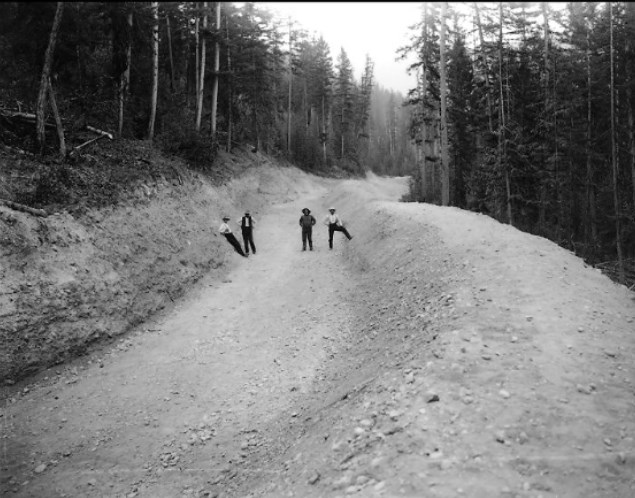
This photo, taken somewhere between 1906 and 1909, shows the magnitude of the Grey Canal.
Image Credit: Submitted/Museum and Archives of Vernon
April 30, 2023 - 8:00 AM
It was mostly foreign land barons who transformed the Coldstream/Vernon area from cattle and hay to fruit in the early part of the 20th Century.
They did it by building what has been touted as the biggest irrigation system in Canada.
“The first settlers who invaded this district, which has now become famous the world over for its fruit, devoted their attention to stock-raising and large bands of cattle for many years roamed the bunch grass slopes,” says an article in The New Empire.
That was a special edition of the Vernon News published in 1937 to promote economic growth in the Okanagan, according to the Museum and Archives of Vernon.
The article bears the title: ‘The Biggest Irrigation System in Canada: The Grey Canal is Unequalled as a Purely Horticultural Project” and was written by J.A. MacKelvie.
The museum's website, however, only puts it as the biggest irrigation system in BC that, at one time, delivered more water than the City of Vancouver.
The Grey Canal is now part of the multitude of hiking and cycling trails that contribute to Greater Vernon’s trademarked name as The Trails Capital of B.C.
READ MORE: COVID made Greater Vernon the Trails Capital of B.C.
But it was the desire of major landowners, many from out of country, to subdivide their land that changed the face of the region.
“With the advent of the railway, came a period of wheat growing and it was in connection with the cultivation of cereals that the first steps were made in irrigation,” MacKelvie wrote. “But, when Lord Aberdeen purchased the Coldstream Ranch back in 1891 and proceeded to experiment on a large scale in fruit growing, a new era dawned on the Okanagan and the first step was made in the evolutionary process which has broken up the large holdings of the cattle barons and the wheat kings, has dotted the country with orchards and is rapidly turning into a vast checkerboard where each square represents a happy and prosperous home.”

Digging the canal in 1914.
Image Credit: Submitted/Museum and Archives of Vernon
While Aberdeen was given credit for this change, he was largely an absentee owner with limited income who, along with others, discovered that orchards needed a lot more water than hay.
In order to raise money, part of the ranch was subdivided and the Coldstream Estates Company was created with most of the shares held by Aberdeen and James Lavington.
READ MORE: iN PHOTOS: Absentee owners a hallmark of historic Coldstream Ranch
It was the Coldstream Ranch manager, Crawley Ricardo who, in 1905, hired engineer A.E. Ashcroft to look at creating an irrigation system from Jones Creek (now called Duteau Creek) with dams on Aberdeen and Haddo lakes in the hills south of Coldstream.
The massive project started with the creation of the White Valley Irrigation and Power Company in 1906 to initially supply the Coldstream Ranch and Estates with water.
It was eventually extended through the BX Ranch, the flat lands around Swan Lake owned by the Belgian Syndicate to Okanagan Lake by 1914 at a cost of almost half a million dollars.
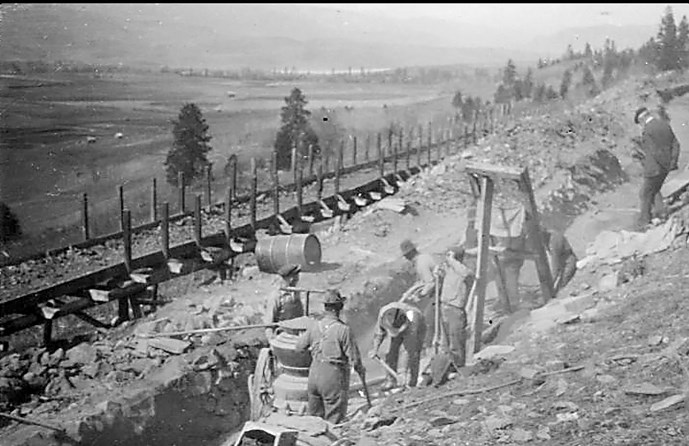
Construction by the Vernon Irrigation District, 1920.
Image Credit: Submitted/Museum and Archives of Vernon
By the time it was completed, the Grey Canal wandered 30 miles (about 50 km) through canals, flumes and ditches throughout the valley.
“The main reason for this large project was the fact part of the Coldstream Ranch was being subdivided,” Ann M. Davis wrote in a 1980 history provided to iNFOnews.ca by the Vernon Museum. “This was a time of great activity in selling land throughout the Okanagan with many of the older cattle ranches being subdivided for orchard land. The competition to sell was intense with irrigated land being more desirable.”
Davis was among a group that put on the first women’s studies course at Okanagan College and ran a consumer consulting service in Vernon in the 1980s.
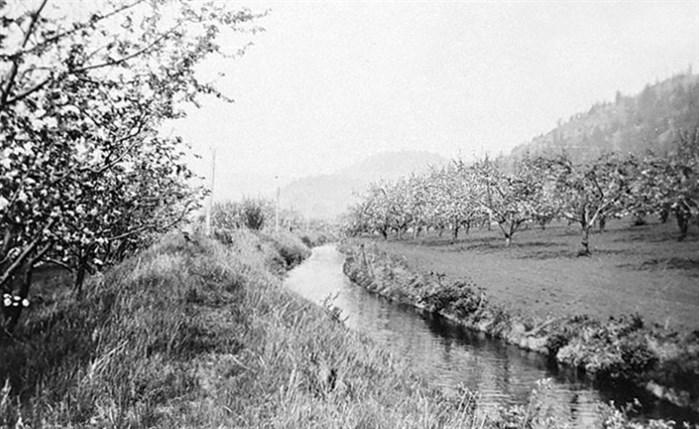
This undated photo shows the Grey Canal filled with water.
Image Credit: Submitted/Museum and Archives of Vernon
One of the major landowners in the area was Albert Henry George, the fourth Earl Grey and Canada’s Governor General of Canada from 1904-11 and owner of the Learmouth Ranch.
He officiated at the opening of the newly-built head gates and intake of the Lavington section in 1906 and named it the Grey Canal.
READ MORE: iN PHOTOS: Treasure trove of historical depictions of life from Kamloops to Osoyoos
The “stupendous undertaking,” as The New Empire article described it, included canals that were eight feet deep and 20 feet wide higher up and two feet wide by the time they reached Okanagan Lake.
Along with the open canals, there were wooden flumes, high trestles and pipes that siphoned the water uphill so that the entire 20,000 acres of land the Grey Canal serviced could be irrigated by gravity.
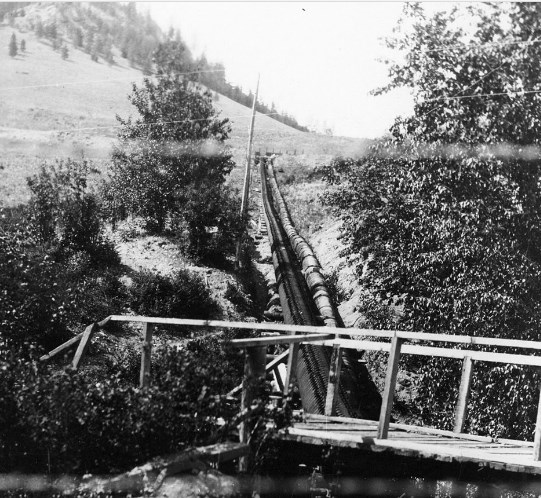
This is the siphon near Lavington in 1908.
Image Credit: Submitted/Museum and Archives of Vernon
The New Empire article describes in some detail the actual route of the irrigation system, starting with a 180-foot long dam on Aberdeen Lake made of cribwork filled with rocks, reinforced with concrete and an earthen dam.
The head gate of the canal was 12 miles downstream after the creek flowed through rugged canyons.
The first mile of the actual canal was through the canyon.
“Part of this section entailing heavy construction work and necessitating a three-foot flume for part of the way, which rests on a trestle over 1,000 feet in length,” The New Empire article says.
Three miles further down, the canal was divided with the main canal being 14 feet across and eight feet deep.
“Six miles above the Coldstream Ranch, at Lavington, the water is siphoned across the valley in a wooden stave pipe a mile and quarter long,” the article says. “To have taken it across in an open viaduct would have been manifestly impossible as it would entail the construction of pillars 338 feet high. Specially constructed pipe 24 and 36 inches in diameter was employed in this work.”
The southern branch travelled for five miles to empty into Deer Creek.
READ MORE: Penticton cop shot and killed by 'Jesse' James on Okanagan Lake more than a century ago
The main canal wound along the hillside to the north of the valley, about 800 feet higher that the town of Vernon.
From there it went through the flat lands of the Belgian Syndicate to the north end of Swan Lake.
“A natural depression of the hills on the west side of the valley forms a small lake and into this, the canal is conducted,” The New Empire article says. “The outlet of this little sheet of water has been dammed and another natural reservoir thus provided.”
Again, bypassing Vernon, the canal continued on to Okanagan Lake.
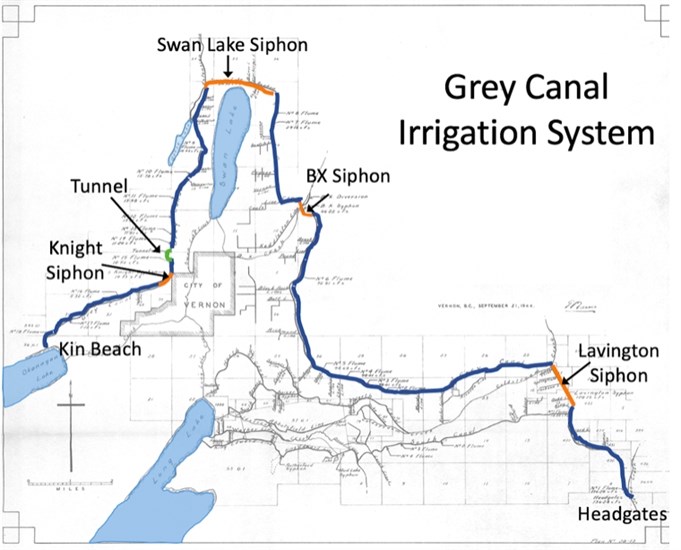
Image Credit: Google Maps
“The source from which the supply for this far-stretching system is taken is from two mountain lakes,” the article says. “As these are fed by a timbered watershed over 150 square miles in area there is no danger that the supply of water thus impounded will ever prove inadequate.”
That turned out not to be true, according to Peter Tassie who wrote a detailed history of the Grey Canal in his book ‘Water from the Hills.’
In a video interview with Ingrid Neumann, a director with the Ribbons of Green Trail Society, Tassie said the seepage losses were so great (25%) that the water often ran out in August.
The canal was also had major financial seepage problems.
It cost $423,000 to build but, by 1915, less than $12,000 had been repaid so repairs could only be made with advances from the government, Davis wrote.
“By 1915, in need of government funding to upgrade the system, landowners petitioned the province to form an improvement district under the Water Act,” says a Memory BC article. “The Vernon Irrigation District was formed in 1920 by amalgamating several agricultural systems.
“Its distribution system consisted of 57 miles of open canals and 37 miles of pipes, most of which were built prior to the district being incorporated.”
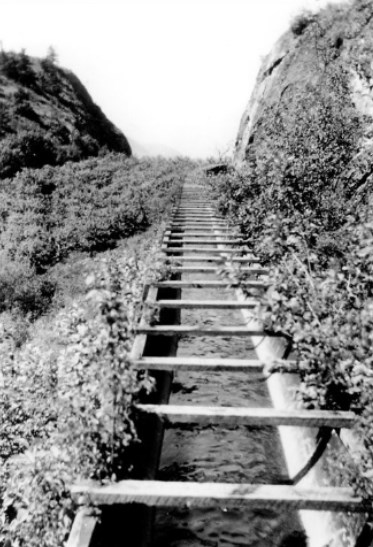
Water though flume #16 above Davison Orachard in 1950.
Image Credit: Submitted/Museum and Archives of Vernon
In the spring of 1922, the Vernon Irrigation District hired more than 100 men to clean and repair the ditches, flumes and pipes.
They tried “guniting,” or cementing, the floor and sides of the canal to reduce seepage. That did not work well so they later turned to a form of asphalt lining and concrete slabs.
By 1923 the system had 23 “ditch walkers” (later called Bailiffs) and foremen to not only do repairs but control the flow of water, Davis wrote.
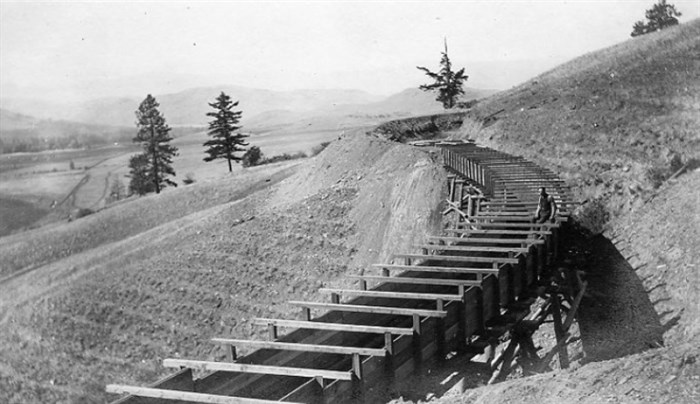
Image Credit: Submitted/Museum and Archives of Vernon
“Orchardists and farmers had to inform the Bailiffs well ahead of how much water they needed every day or week,” she wrote.
Tassie talked about his ditchwalker who would start early in the morning and walk about 12 miles a day, six days a week controlling the flow into each property.
For some of the more remote properties, the ditchwalkers were a welcome social contact to isolated farmers, he said.
By 1930, Tassie said, the irrigation district owed the province $1 million.
Davis cites an irrigation district report that said in 1943, the district “suffered appreciable damage to its works through troops being trained on the Coldstream Ranch, the shelling of the Grey Canal is a serious matter.”
Wooden flumes also had short life spans so the cost of maintenance was expensive and ongoing so they were slowly replaced by metal pipes.
READ MORE: iN PHOTOS: Here’s why there’s a never-ending war over the road in Kalamalka Lake park
In 1965 the provincial Water Resources Service presented a study to the Vernon Irrigation District trustees that convinced them to convert to a pressure pipeline.
“This spelled the beginning of the end of the Grey Canal,” Davis wrote.
The last water flowed through the Grey Canal in the spring of 1970. After that, some of the canal was dismantled.
“The Grey Canal, serving the residents of Coldstream, BX, Swan Lake and Okanagan Landing so well for so many years is now almost forgotten, a curiosity to those who bother to investigate the obvious man-made change in the landscape,” Davis wrote.
“It lies dry, grass covered, old pieces of cement blocks on the ground, cement gates and support for flumes crumbling in the sun and rain. It would make a wonderful bicycle or walking route around Vernon with superb views of City, Valley and mountain and who knows, in these days of increased leisure, this may one day be a reality.”
That proved prophetic but it wasn’t until 2005 that the regional district approached the Ribbons of Green Trail Society and asked them to take on the project, society director Ingrid Neumann told iNFOnews.ca.
That was spearheaded by current Vernon Mayor Victor Cumming who was a director, then president of the society.
Over the years, seven sections of the trail in the Vernon area have been acquired and developed, Neumann said, totalling about 30 km. There are still a couple of gaps in that part of the trail.
Some day, the trail network may be extended to the head gate at Lavington, covering the entire Grey Canal.
For more on the Grey Canal Trail network, go to the Ribbons of Green website, here.
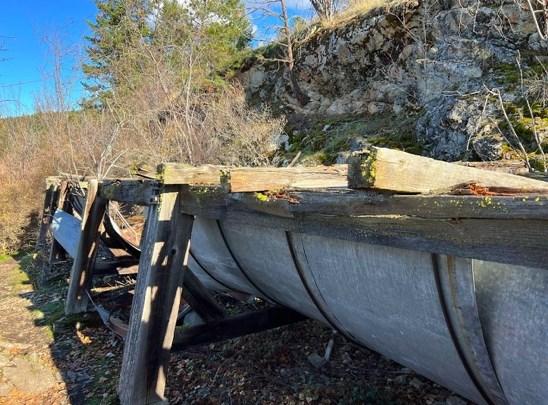
Flume remnants as they are now on east side of Swan Lake.
Image Credit: Submitted/Ribbons of Green Trails Society
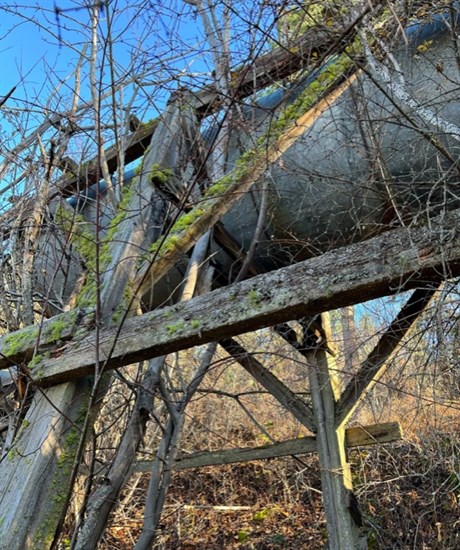
East side of Swan Lake.
Image Credit: Submitted/Ribbons of Green Trails Society
To contact a reporter for this story, email Rob Munro or call 250-808-0143 or email the editor. You can also submit photos, videos or news tips to the newsroom and be entered to win a monthly prize draw.
We welcome your comments and opinions on our stories but play nice. We won't censor or delete comments unless they contain off-topic statements or links, unnecessary vulgarity, false facts, spam or obviously fake profiles. If you have any concerns about what you see in comments, email the editor in the link above.
News from © iNFOnews, 2023